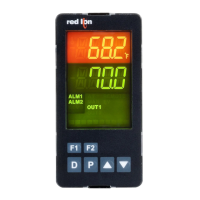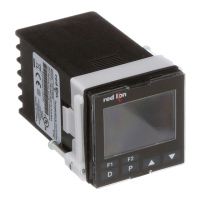1
MODEL PXU - TEMPERATURE/PROCESS CONTROLLERS
GENERAL DESCRIPTION
The PXU controller accepts signals from a variety of temperature sensors
including thermocouple or RTD. The controller can also be configured for
process inputs including 0 to 5/10 VDC, 0/4 to 20 mA DC, or 0 to 50 mV DC.
The PXU can provide an accurate output control signal (time proportional or DC
Analog Output) to maintain a process at a determined setpoint value. Dual
4-digit display readings allow viewing of the temperature/process and setpoint
value simultaneously. Front panel indicators inform the operator of alarm and
control output status. Comprehensive programming features allow this controller
to meet a wide variety of application requirements.
MAIN CONTROL
The PXU allows the user to select between PID, On/Off and Manual control
mode. The PXU has the ability to provide 2 control outputs. The control outputs
can be individually configured for Reverse or Direct (heating or cooling)
applications. The PID tuning constants can be established via on-demand auto-
tune. The PID constants can also be programmed, or fine-tuned, through the
front panel or a PC and then locked out from further modification.
ALARMS
Alarm(s) can be configured independently for absolute high or low acting
with balanced or unbalanced hysteresis. They can also be configured for
deviation and band alarm. In these modes, the alarm trigger values track the
setpoint value. Adjustable alarm hysteresis can be used for delaying output
response. The alarms can be programmed for Automatic or Latching operation.
A selectable standby feature suppresses the alarm during power-up until the
temperature stabilizes outside the alarm region.
CONSTRUCTION
The PXU is constructed of a lightweight, high impact, black plastic textured
case with a clear display window. Modern surface-mount technology, extensive
testing, plus high immunity to noise interference makes the controller extremely
reliable in industrial environments.
SAFETY SUMMARY
All safety related regulations, local codes and instructions that appear in the
manual or on equipment must be observed to ensure personal safety and to
prevent damage to either the instrument or equipment connected to it. If
equipment is used in a manner not specified by the manufacturer, the protection
provided by the equipment may be impaired.
Do not use this unit to directly command motors, valves, or other actuators not
equipped with safeguards. To do so can be potentially harmful to persons or
equipment in the event of a fault to the controller. If redundant safeguards are not
in place, an independent and redundant temperature limit indicator with alarm
outputs is strongly recommended.
z PID CONTROL
z ACCEPTS TC and RTD
z ACCEPTS 0-10 V, 0/4-20 mA or 0-50 mV SIGNALS
z FUNCTIONS AS A DIGITAL POT
z ON DEMAND AUTO-TUNING OF PID SETTINGS
z DC ANALOG CONTROL OUTPUT (OPTIONAL)
z 2 USER PROGRAMMABLE FUNCTION BUTTONS
z PC (MODELS WITH RS 485) OR FRONT PANEL PROGRAMMING
z 1/16, 1/8 or 1/4 DIN
z CONTROLLERS MEET IP65 REQUIREMENTS
Bulletin No. PXU-D
Drawing No. LP0932
Released 09/15
C
US LISTED
U
L
R
13RW
PROCESS CONTROL EQUIPMENT
(48.0)
1.89
1.89
(48.0)
(45.0)
1.77
1.77
(45.0)
6
5
4
3
2
1
12
11
10
9
8
7
15
14
13
16
17
18
0.26
(6.70)
3.14 (79.70)
0.31
(7.80)
0.47 (11.88)
0.83 (21.0)
DIMENSIONS In inches (mm) - 1/16 DIN
PANEL CUT-OUT
CAUTION: Risk of electric shock.
When the power is on, DO NOT touch the AC terminals, an electric shock may
occur. Make sure the power is disconnected when you check the input power
supply.
1. Prevent dust or metallic debris from falling into the controller and causing malfunctions. DO
NOT modify the controller.
2. The PXU is an open-type device. Make sure it is installed in an enclosure free of dust and
humidity in case of an electric shock.
3. Wait for one minute after the power is switched off to allow the unit to discharge. DO NOT
touch the internal wiring within this period of time.
CAUTION: Risk of Danger.
Read complete instructions prior to
installation and operation of the unit.





